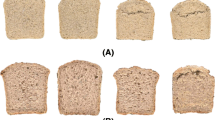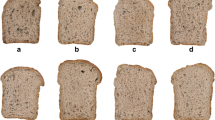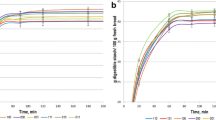Abstract
The significance of heat moisture treatment (HMT, 15% moisture content, 1 h and 120 °C) of single common wheat (WT), teff (T), chestnut (CN) and whole chickpea (CP) flours has been investigated (a) on main chemical, nutritional and functional flour parameters and (b) on visco-metric and thermal behaviours of treated blended breads. Characterization of native and HMT flours evidenced significant (p < 0.05) but discreet effects of the thermal treatment of flours on main functional parameters in terms of promotion of the ability of the flour to associate with water and of the formation of water-soluble molecules from small fragments of amylopectin or amylose. Dilution of the basic wheat flour system by accumulative addition of T, CN and CP flours submitted to partial or total HMT did impact on the disorganization and later reorganization of starch components of the starch-rich blended matrices in excess of water (pasting, gelling) and under water restrictions (retrogradation kinetics). Simultaneous presence of T/CN, T/CP and CN/CP either singly or fully thermally treated provided enhancement of the visco-metric profile on pasting and gelling, and decreased the extent and the rate of amylopectin crystallization on ageing.



Similar content being viewed by others
References
AACC. (2005). Approved methods of the American Association of Cereal Chemists (10th ed.). AACC St. Paul, MN: The Association.
Adebowale, K. O., Afolabi, T. A., & Olu-Owolabi, B. I. (2005). Hydrothermal treatments of finger millet (Eleusine coracana) starch. Food Hydrocolloids, 19(6), 974–983.
Angioloni, A., & Collar, C. (2009). Bread crumb quality assessment: A plural physical approach. European Food Research and Technology, 229(1), 21–30.
Balasubramanian, S., Sharma, R., & Kaur, J. (2014). Characterization of modified pearl millet (Pennisetum typhoides) starch. Journal of Food Science and Technology, 51(2), 294–300.
BeMiller, J. N., & Huber, K. C. (2015). Physical modification of food starch functionalities. Annual Review of Food Science and Technology, 6(1), 19–69.
Berski, W., Ziobro, R., Witczak, M., & Gambuś, H. (2018). The retrogradation kinetics of starches of different botanical origin in the presence of glucose syrup. International Journal of Biological Macromolecules, 114, 1288–1294.
Biliaderis, C. G. (2009). Structural transitions and related physical properties of starch. In A. Press (Ed.), Starch: Chemistry and technology, third edition. J. BeMiller, R. whistler (pp. 293–372). USA: Elsevier, Burlington.
Biliaderis, C. G., Page, C. M., Slade, L., & Sirett, R. R. (1985). Thermal behavior of amylose-lipid complexes. Carbohydrate Polymers, 5(5), 367–389.
Bolade, M. K., Usman, M. A., Rasheed, A. A., Benson, E. L., & Salifou, I. (2002). Influence of hydrothermal treatment of maize grains on the quality and acceptability of tuwon masara (traditional maize gel). Food Chemistry, 79(4), 479–483.
Case, S. E., Hamann, D. D., & Schwartz, S. J. (1992). Effect of starch gelatinization on physical properties of wheat and corn based products. Cereal Chemistry, 69, 401–404.
Cetiner, B., Acar, O., Kahraman, K., Sanal, T., & Koksel, H. (2017). An investigation on the effect of heat-moisture treatment on baking quality of wheat by using response surface methodology. Journal of Cereal Science, 74, 103–111.
Collar, C. (2016a). Role of Bread on Nutrition and Health Worldwide. In C. M. Rosell, J. Bajerska, & A. F. El Sheikha (Eds.), Bread and its fortification. Nutritional and health benefits (pp. 26–52). Boca Ratón: CRC Press/ Taylor & Francis Group.
Collar, C. (2016b). Impact of visco-metric profile of composite dough matrices on starch digestibility and firming and retrogradation kinetics of breads thereof: Additive and interactive effects of non-wheat flours. Journal of Cereal Science, 69, 32–39.
Collar, C. (2017). Significance of heat moisture treatment conditions on the pasting and gelling behaviour of various starch-rich cereal and pseudocereal flours. Food Science and Technology International, 23(7), 623–636.
Collar, C., & Armero, E. (2018a). Impact of heat moisture treatment and hydration level on physico-chemical and viscoelastic properties of doughs from wheat-barley composite flours. European Food Research and Technology, 244(2), 355–366.
Collar, C., & Armero, E. (2018b). Significance of heat moisture treatment and hydration level of flours on the functional and nutritional value of wheat-barley composite breads. Food and Bioprocess Technology, 11(5), 966–978.
Collar, C., & Armero, E. (2018c). Value-added dough-based fermented mixed matrices by applying heat moisture treatment to non-wheat flours: A functional and nutritional approach of blends. Food and Bioprocess Technology, 11(8), 1536–1551. https://doi.org/10.1007/s11947-018-2125-2.
Collar, C., & Armero, E. (2018d). Kinetics of in vitro starch hydrolysis and relevant starch nutritional fractions in heat-moisture treated blended wheat-based bread matrices: Impact of treatment of non-wheat flours. European Food Research and Technology, 244(11), 1977–1984. https://doi.org/10.1007/s00217-018-3109-1.
Collar, C., Jiménez, T., Conte, P., & Piga, A. (2015). Significance of thermal transitions on starch digestibility and firming kinetics of restricted water mixed flour bread matrices. Carbohydrate Polymers, 122, 169–179.
Copeland, L., Blazek, J., Salman, H., & Tang, C. M. (2009). Form and functionality of starch. Food Hydrocolloids, 23(6), 1527–1534.
Dharmaraj, U., & Malleshi, N. G. (2011). Changes in carbohydrates, proteins and lipids of finger millet after hydrothermal processing. LWT- Food Science and Technology, 44(7), 1636–1642.
Gebremariam, M. M., Zarnkow, M., & Becker, T. (2014). (Teff Eragrostis tef) as a raw material for malting, brewing and manufacturing of gluten-free foods and beverages: A review. Journal of Food Science and Technology, 51(11), 2881–2895.
Gray, J., & BeMiller, J. N. (2003). Bread staling: Molecular basis and control. Comprehensive Reviews in Food Science and Food Safety, 2(1), 1–21.
Gunaratne, A., & Hoover, R. (2002). Effect of heat-moisture on the structure and physicochemical properties of tuber and root starches. Carbohydrate Polymers, 49(4), 425–437.
Han, H., & Baik, B.-K. (2008). Antioxidant activity and phenolic content of lentils (Lens culinaris), chickpeas (Cicer arietinum L.), peas (Pisum sativum L.) and soybeans (Glycine max), and their quantitative changes during processing. International Journal of Food Science and Technology, 43(11), 1971–1978.
Hoover, R., Hughes, T., Chung, H. J., & Liu, Q. (2010). Composition, molecular structure, properties, and modification of pulse starches: A review. Food Research International, 43(2), 399–413.
Hug-Iten, S., Escher, F., & Conde-Petit, B. (2003). Staling of bread: Role of amylose and amylopectin and influence of starch-degrading enzymes. Cereal Chemistry, 80(6), 654–661.
ICC, 1976–1996. ICC Standard Methods of the International Association for Cereal Chemistry. 104/1, 105/2, 110/1, 115/1, 136, 162, 166. The Association: Vienna.18.
Lan, H., Hoover, R., Jayakody, L., Liu, Q., Donner, E., Baga, M., Asare, E. K., Hucl, P., & Chibbar, R. N. (2008). Impact of annealing on the molecular structure and physicochemical properties of normal, waxy and high amylose bread wheat starches. Food Chemistry, 111(3), 663–675.
Lawal, O. S. (2009). Starch hydroxyalkylation: Physicochemical properties and enzymatic digestibility of native and hydroxypropylated finger millet (Eleusine coracana) starch. Food Hydrocolloids, 23(2), 415–425.
LeBail, P., Bizot, H., & Buleon, A. (1993). ‘B’ to ‘A’ type phase transition in short amylose chains. Carbohydrate Polymers, 21, 99–104.
Lorlowhakarn, K., & Naivikul, O. (2006). Modification of rice flour by heat moisture treatment (HMT) to produce rice noodles. Kasetsart Journal (Natural Science), 40, 135–143.
Lu, S., Chen, C. Y., & Lii, C. Y. (1996). Gel-chromatography fractionation and thermal characterization of rice starch affected by hydrothermal treatment. Cereal Chemistry, 73, 5–11.
Mann, J., Schiedt, B., Baumann, A., Conde-Petit, B., & Vilgis, T. A. (2013). Effect of heat treatment on wheat dough rheology and wheat protein solubility. Food Science and Technology International, 20, 341–351.
Marston, K., Khouryieh, H., & Aramouni, F. (2016). Effect of heat treatment of sorghum flour on the functional properties of gluten-free bread and cake. LWT- Food Science and Technology, 65, 637–644.
Moreira, R., Chenlo, F., Torres, M. D., & Prieto, D. M. (2012). Technological assessment of chestnut flour doughs regarding to doughs from other commercial flours and formulations. Food and Bioprocess Technology, 5(6), 2301–2310. https://doi.org/10.1007/s11947-011-0524-8.
Morrison, W. R., & Laignet, B. (1983). An improved colorimetric procedure for determining apparent and total amylose in cereal and other starches. Journal of Cereal Science, 1(1), 9–20.
Nakamura, C., Yoshiki, K., & Seguchi, M. (2008). Increased volume of Kasutera cake by dry heating of wheat flour. Food Science and Technology Research, 14(5), 431–436.
Nakamura, S., Okumura, H., Sugawara, M., Noro, W., Homma, N., & Ohtsubo, K. (2017). Effects of different heat–moisture treatments on the physicochemical properties of brown rice flour. Bioscience Biotechnology and Biochemistry, 81(12), 2370–2385. https://doi.org/10.1080/09168451.2017.1387047.
Neill, G., Al-Muhtase, A. H., & Magee, T. R. A. (2012). Optimisation of time/temperature treatment, for heat treated soft wheat flour. Journal of Food Engineering, 113(3), 422–426.
Nelson, L. (2001). Properties of high-fibre ingredients. Cereal Foods World, 46, 93–97.
Purhagen, J. K., Sjöö, M. E., & Eliasson, A. (2011). The use of normal and heat-treated barley flour and waxy barley starch as anti-staling agents in laboratory and industrial baking processes. Journal of Food Engineering, 104(3), 414–421.
Putseys, J. A., Lamberts, L., & Delcour, J. A. (2010). Review. Amylose-inclusion complexes: Formation, identity and physico-chemical properties. Journal of Cereal Science, 51(3), 238–247.
Robin, F., Théoduloz, C., & Srichuwong, S. (2015). Properties of extruded whole grain cereals and pseudocereals flours. International Journal of Food Science and Technology, 50(10), 2152–2159.
Shobana, S., & Malleshi, N. G. (2007). Preparation and functional properties of decorticated finger millet (Eleusine coracana). Journal of Food Engineering, 79(2), 529–538.
Singh, J., Singh, N., Sharma, T. R., & Saxena, S. K. (2003). Physicochemical, rheological and cookie making properties of corn and potato flours. Food Chemistry, 83(3), 387–393.
Takahashi, T., Miura, M., Ohisa, N., & Mori, K. (2005). Kobayashi heat treatments of milled rice and properties of the flours. Cereal Chemistry, 82(2), 228–232.
Traynham, T. L., Myers, D. J., Carriquiry, A. L., & Johnson, L. A. (2007). Evaluation of water-holding capacity for wheat-soy flour blends. Journal of the American Oil Chemists' Society, 84(2), 151–155.
Verdú, S., Vásquez, F., Ivorra, E., Sánchez, A. J., Barat, J. M., & Grau, R. (2017). Hyperspectral image control of the heat-treatment process of oat flour to model composite bread properties. Journal of Food Engineering, 192, 45–52.
Yadav, N., Kaur, J., Anand, T., & Singh, A. K. (2012). Storage stability and pasting properties of hydrothermally treated pearl millet flour. International Journal of Food Science and Technology, 47(12), 2532–2537.
Zavareze, E. R., & Dias, A. R. G. (2011). Impact of heat-moisture treatment and annealing in starches: A review. Carbohydrate Polymers, 83(2), 317–328.
Funding
The authors acknowledge the Institutions Ministerio de Economía y Competitividad (MINECO) and Federación Europea de Desarrollo Regional (FEDER) for funding the Project AGL2015-63849-C2-1-R.
Author information
Authors and Affiliations
Corresponding author
Ethics declarations
Conflict of Interest
The authors declare that they have no conflict of interest.
Additional information
Publisher’s Note
Springer Nature remains neutral with regard to jurisdictional claims in published maps and institutional affiliations.
Rights and permissions
About this article
Cite this article
Collar, C., Armero, E. Functional and Thermal Behaviours of Heat-Moisture-Treated Starch-Rich Wheat-Based Blended Matrices: Impact of Treatment of Non-wheat Flours. Food Bioprocess Technol 12, 599–612 (2019). https://doi.org/10.1007/s11947-019-2238-2
Received:
Accepted:
Published:
Issue Date:
DOI: https://doi.org/10.1007/s11947-019-2238-2




